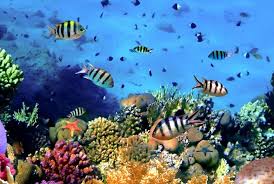Aquatic environment include freshwater, brackish water and marine which are all in various forms. Fresh water may include lakes and ponds which are static or standing (lentic habitat) while rivers, marine water or ocean is moving or running (lotic habitat) and the study of fresh water ecosystems is known as limnology.
Because of the particular environmental effect posed by the different water bodies and across different climatic regions some unique combinations of adaptive features have evolved for the survival of fish. These include adaptations to arid conditions, variable water levels, fire and high salinity.
The Aquatic Habitat

Aquatic Life, in this context, relates to organisms that either permanently or periodically inhabits areas associated with permanent or ephemeral freshwater or naturally saline systems and riparian zones. Such areas include rivers, streams, creeks, lakes (permanent or ephemeral), swamps and floodplains.
These organisms include crustaceans, fish, turtles and aquatic flora. Open Ocean or pelagic organisms live in four major bio-zones known as the epipelagic, mesopelagic, bathypelagic, and abyssopelagic zones. Several scientists define these zones with the following depths:
• The epipelagic zone (0-100 meters) is the zone in which sufficient light penetrates to allow photosynthesis.
• The mesopelagic zone extends from depths of approximately 200 meters to 1000 meters.
• The bathypelagic zone extends from 1000 meters to 3000 meters, and
• The abyssopelagic zone extends from 3000 meters to the bottom.
Read Also: Commercially Important Fish and Shell Fish Species
The physical environment of these zones varies with the availability of light, oxygen and food resources, pressure levels, and temperature. These physical factors allow a great diversity of organisms. Some organisms may be found in only one zone, while others inhabit more than one zone.
Under these varying conditions, marine organisms have adapted and survived. To survive, these organisms must secure food, avoid predation, and successfully reproduce. Adaptive features may include size, coloration, defensive and reproductive strategies,
bioluminescence, and specialized teeth and jaws.
Due to the limited amount of food in the lower zones, larger organisms tend to live in the upper zones, while organisms living in deep water tend to be smaller.
However, there are certain limiting factors to their existence in water and these are given below.
Classes of Aquatic Organisms
Fresh water organisms can be classified as follows:
(i) Benthos- These are bottom dwelling organisms e.g. flatworms and rhizopods.
(ii) Periphyton-These are organisms with attaching mechanisms to the rest of plants or projecting surfaces like rock e.g. algae and diatoms.
(iii) Plankton- These are floating organisms whose movements depends upon currents e.g. diatoms and desmids.
(iv) Nekton- Theses are swimming organisms such as fish and amphibians.
(v) Neuston- They are organisms resting or swimming on surface e.g. insects.
Important Limiting Factors in Aquatic Habitat
(i) Temperature: Pond waters and lakes undergo seasonal temperature changes annually and these result in the creation of definite patterns of circulation and stratification of water column.
Since aquatic organisms which include fish have narrow tolerance in water temperature levels, it thus greatly influences their activities.
(ii) Dissolved Oxygen: The total amount of oxygen that is dissolved in water is the one available for aquatic animals to use since fish do not depend on atmospheric oxygen for survival. The amount of dissolved oxygen in water has been discovered to be greatest near the surface while it decreases with depth.
(iii) Salinity: The concentration of salt in which aquatic organisms is found varies greatly from fresh water to brackish and marine waters. This clear distinction gave rise to categorisation of certain fish species into fresh water fish and marine or brackish water fish species thereby averting problem of osmoregulation.
(iv) Light: Light penetration can be affected by suspended solids thereby affecting turbidity of the water body. It plays a vital role in photosynthetic activities of various aquatic plants.
(v) Currents: The surface waves caused by the wind pressure affect the shore line and shore organisms consequently, currents affect the distribution of nutrients and small aquatic organisms in the water.
Read Also: Classification of Some Exotic/Foreign Fin Fish Species
Read Also: Metabolic Wastes Complete Management Guide






